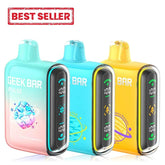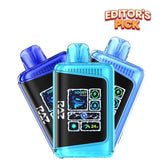Heat Not Burn vs Vaping: What To Choose?
If you think quitting smoking cigarettes is easy, well think again. No one can quit without some sort of help. When someone needs a helping hand, they look for alternative methods of traditional smoking. So the question to start the article is, "What do you choose to quit, vaping or Heat-not-burn?"
Well, this might be a tricky question before understanding the difference between vaping and heat-not-burn. Let’s dig into the following information to make a wise decision.

Heat Not Burn
Heat-not-burn is a method of inhaling nicotine without burning the tobacco or cigarette stick. This may sound confusing but it's not once you understand it.
What is Heat Not Burn Product?
Heat-not-burn products are tobacco heating devices. They heat the tobacco instead of burning it like traditional cigarettes do. Using a heat-not-burn device is a method to provide the user with a potentially reduced-risk alternative to smoking. However, these products are considered alternative nicotine delivery systems. Still, they are different from electronic cigarettes or vaping devices. To better understand how they are different from vaping, firstly, you should understand the work process of heat-not-burn.

How Does it Work?
Well, here is how a heat-not-burn product works to give a nicotine hit without burning it:
Heating Element
The heat-not-burn device contains a heating element to heat the tobacco to a controlled temperature. This heating element can be a metal plate or a ceramic plate. You can choose your device as per your preferences.
The heating element doesn't touch the tobacco but gets very close. It uses conduction heating to heat it just far enough to not burn it. The heating element heats up to 350° Celsius.
Tobacco Insert
You will need to use a tobacco insert (a heat stick containing processed tobacco) inside the device. This stick is specially designed to heat the tobacco instead of burning it like cigarettes.
You will need to buy these from the manufacturer or a store that sells the heat not burn product. They usually resemble half sized cigarettes with the filter.
Heating Process
When you activate the heat-not-burn device, the heating plate will warm up to a certain point and start heating the tobacco rather than combusting it. This produces an aerosol or vapor containing nicotine and other components of the tobacco.
Inhalation
Now, it's time to inhale the aerosol or vapor heated by the heat-not-burn device. You can inhale the vapors like you smoke a traditional cigarette. When you inhale the aerosol, the nicotine will pass to your bloodstream through the lungs. It will give you the desired nicotine hit that you were seeking from a traditional cigarette.

What Do You Use It With?
Heat-not-burn products are used with specific devices designed for that purpose. Here are the main types of devices used with heat-not-burn products.
Tobacco Heating Systems
Tobacco heating devices, like TQS Coolplay Q3, are specifically designed to heat tobacco sticks or capsules. These devices contain a heating chamber or heat plate (made with ceramic or metal) where you will insert the tobacco stick.
Heat Sticks/Capsules
As mentioned before, heat-not-burn products need tobacco sticks or capsules to get vapors without burning the tobacco. You can check out our product section to purchase top-quality sticks, such as TQS Non-Tobacco Herbal Sticks, which is packed with different flavors.

What Are The Effects of Heat Not Burn?
The effects of using heat-not-burn products can vary depending on various factors, such as specific products, usage patterns, and health considerations. Let's dig into the possible effects of using heat-not-burn products:
Give Nicotine Hit Like Cigarette
Heat-not-burn products are the best alternative to traditional smoking after vaping. When a user starts the heat-not-burn, it heats the processed tobacco stick inserted in the heating chamber and releases aerosol or vapor infused with nicotine. The user inhales these vapors and gets the desired effects, such as relaxation or stimulation via nicotine, as they get hit by traditional cigarettes.
Reduced Exposure to Harmful Chemicals
Compared to traditional cigarettes, heat-not-burn products are generally believed to produce fewer harmful chemicals. By heating the tobacco rather than burning it, the levels of certain toxicants and carcinogens associated with combustion may be reduced. However, it's important to note that heat-not-burn products are not risk-free and still contain potentially harmful substances.
Respiratory Effects
Using heat-not-burn products may still have respiratory effects, albeit potentially less severe than traditional smoking. Inhalation of the aerosol or vapor can lead to throat irritation, coughing, and other respiratory symptoms. The long-term respiratory health effects of using heat-not-burn products are still being studied.
Addiction and Withdrawal
As you know, heat-not-burn products do have nicotine content. They may lead to nicotine addiction, similar to traditional cigarettes. Regular use may result in dependence and withdrawal symptoms when attempting to quit.
Cardiovascular Effects
Nicotine has cardiovascular effects, including increased heart rate and blood pressure. If you use this product for a long time or are addicted, you can invite cardiovascular risks that no one wants. Although, these risks may be lower than traditional smoking. Still, take care of heat-not-burn-using habits before it's too late.

Does Heat Not Burn Smell?
Heat-not-burn products can produce an aroma. It is generally milder compared to the strong and lingering smell of traditional cigarette smoke. The specific odor and intensity can vary depending on factors such as the brand of the product, the temperature at which the tobacco is heated, and individual sensitivity to fragrances. Here are some key points regarding the smell associated with heat-not-burn products:
Tobacco Odor
While the odor produced by heat-not-burn products is typically less pungent than that of burning tobacco, there is still a noticeable smell. The aroma is often described as a mix of heated tobacco and a faint, toasted scent. However, the smell tends to dissipate more quickly compared to the lingering smell of traditional cigarette smoke.
Vapor or Aerosol Scent
Heat-not-burn products generate an aerosol or vapor that contains nicotine and other constituents. This aerosol can contribute to a slight scent, which may be different from the strong, lingering smell of cigarette smoke. However, the odor tends to be less pronounced and dissipates more rapidly.
What Are The Most Popular Heat Not Burn Brands?
Several popular heat-not-burn brands on the market, each with unique offerings and product lines. Here are some of the well-known heat-not-burn brands:
TQS (Time to quality smoking to get a healthy life)
The TQS was established in October 2019. Its focus lies in offering harm reduction through HeatNotBurn products. TQS tobacco sticks are designed to potentially provide health benefits in the foreseeable future. Their TQS tobacco sticks have undergone rigorous testing and have received multiple certifications to ensure safety and quality. These include MSDS certifications for PG, VG, nicotine, and PLA filter, and FDA and RoHS certificates for material safety. Moreover, the tobacco sticks are nicotine-free, free from harmful heavy metals, and do not produce harmful smoke fumes.
IQOS (by Philip Morris International)
IQOS is one of the most recognized heat-not-burn brands globally. It is developed and marketed by Philip Morris International (PMI). IQOS devices heat specially designed tobacco sticks called HEETS to create an aerosol for inhalation.
Glo (by British American Tobacco)
Glo, produced by British American Tobacco (BAT), is another prominent heat-not-burn brand. Glo devices heat tobacco sticks known as NeoStiks, releasing an aerosol that can be inhaled by users.
Ploom (by Japan Tobacco International)
Ploom, developed by Japan Tobacco International (JTI), is a heat-not-burn brand popular in several markets. The Ploom devices heat tobacco capsules or sticks to produce vapor or aerosol for inhalation.
Lil (by KT&G)
Lil, a brand from the South Korean company KT&G, has gained popularity in certain regions. Lil devices heat specially designed tobacco sticks, providing an alternative method of tobacco consumption.

What's The Difference Between Vaping and Heat Not Burn?
Vaping and heat-not-burn (HNB) are both forms of consuming nicotine or tobacco. Still, both methods have differences, including their mechanisms and the substances involved. Here are the major dissimilarities between vaping and heat-not-burn:
Operation and Heating Mechanism
Vaping
Vaping devices, such as vape disposable, e-cigarettes or vape pens, heat a liquid solution (e-liquid or vape juice) containing nicotine, flavorings, and other additives. This liquid is vaporized by an atomizer or heating element, producing an aerosol or vapor inhaled by the user.
Heat-not-burn
Heat-not-burn devices are specifically designed to heat processed tobacco rather than burn it. The tobacco is heated to a controlled temperature using a heating element or system, producing an aerosol or vapor that is inhaled.
Substances Used
Vaping
In vaping, the user uses e-liquids, which typically consist of nicotine, propylene glycol (PG), vegetable glycerin (VG), flavorings, and possibly other additives. The nicotine in e-liquids is derived from various sources, including tobacco.
Heat-not-burn
Heat-not-burn products primarily involve the use of specially designed tobacco sticks, capsules, or inserts. These products contain processed tobacco, which is heated to release nicotine and other constituents of tobacco.

Emissions and Odor
Vaping
Vaping produces an aerosol or vapor that can be flavored and scented, depending on the e-liquid used. The emissions from vaping can have a distinct aroma but tend to dissipate more quickly than traditional cigarette smoke. Sometimes the smell is so faint, you can't smell it.
Heat-not-burn
Heat-not-burn products produce an aerosol or vapor that may have a milder odor compared to burning tobacco, but it still emits a noticeable scent. The odor is often described as a mix of heated tobacco and a faint toasted smell.
Regulation and Perception
Vaping
The regulatory landscape for vaping varies worldwide, with different countries implementing their own rules and restrictions. Vaping has faced scrutiny due to concerns about youth use, potential long-term health effects, and the marketing of flavored products.
Heat-not-burn
Heat-not-burn products have been marketed as potentially reduced-risk alternatives to smoking. However, regulatory frameworks for these products also differ by country, and their long-term health effects are still being studied.














